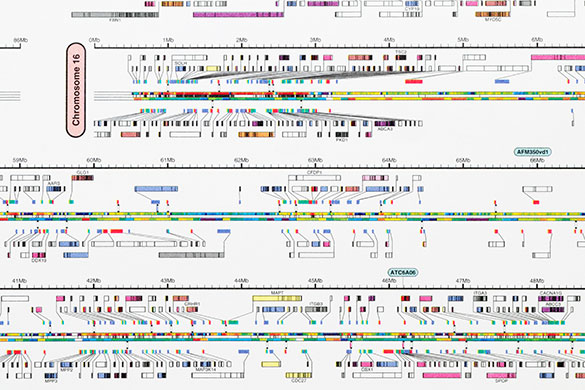

Fluorescence in situ hybridization ( FISH) was also used to Library clones in order to identify overlapping clones. Each library clone exhibited aĭNA fragment "fingerprint," which could be compared to that of all other Restriction enzyme HindIII, and the sizes of the resulting DNA fragments wereĭetermined using agarose gel electrophoresis. Library clones were also digested with the To chromosomal regions by screening for sequence-tagged sites (STSs), which areĭNA fragments, usually less than 500 base pairs in length, of known sequenceĪnd chromosomal location that can be amplified using polymerase chain reaction (PCR). When possible, the DNA fragments within the library vectors were mapped Restriction enzyme digestion of genomic DNA from anonymous human donors intoīacterial artificial chromosome vectors, which could be propagated in bacteria. The clones wereĭerived from DNA libraries made by ligating DNA fragments generated by partial Sequenced using a shotgun approach (Figure 2). Shotgun method, because the team members systematically generated overlappingĬlones mapped to individual human chromosomes, which were individually The approach used by the members of the IHGSC was called the hierarchical The shotgun phase of the Human Genome Project itself consisted of threeĭata from multiple clones to determine overlap and establish a contiguous The shotgun phase yielded 90% of the human genome sequence in draft form. Genomic Sequences (HTGS) division of GenBank by the end of the shotgun phase. Figure 1 shows theĮxponential increase in DNA sequence information deposited in the High-Throughput In ambiguous areas not obtained during the shotgun phase. Next, the second phase of the project,Ĭalled the finishing phase, involved filling in gaps and resolving DNA sequences Platform for generating and analyzing the massive amounts of DNA sequence data Physical map of the human genome established earlier, which served as a Phase, divided human chromosomes into DNA segments of anĪppropriate size, which were then further subdivided into smaller, overlappingĭNA fragments that were sequenced. Genome Project employed a two-phase approach to tackle the human genome
#WHEN WAS HUMAN GENOME MAPPED FULL#
Successful, the sequencing of the human genome proceeded with full force.īased on the insights gained from the yeast and worm studies, the Human The human and mouse genomes, and (2) sequencing the smaller yeast and worm genomes as a test run for sequencing the larger, Just as the Human Genome Project revolved around two key principles, itĪlso started with two early goals: (1) building genetic and physical maps of Human Genome Project by the time of its completion. More than 18 different countries from across the globe had contributed to the Department of Energy to support these efforts. At any given time, approximatelyĢ00 labs in the United States were funded by either the National Institutes of Novel discoveries by researchers of all types. Scientists in academia and in industry, and it provided the means for rapid and This founding principle ensured unrestricted access for

Human genome sequence information be freely and publicly available within 24 The group of publicly funded researchers that eventuallyĪssembled was known as International Human Genome Sequencing Consortium (IHGSC). Nation in an effort to move beyond borders, to establish an all-inclusive effortĪimed at understanding our shared molecular heritage, and to benefit fromĭiverse approaches. First, it welcomed collaborators from any Human Genome Sequencing Consortium, 2001). From its inception, the Human Genome Project revolved around two key


 0 kommentar(er)
0 kommentar(er)
